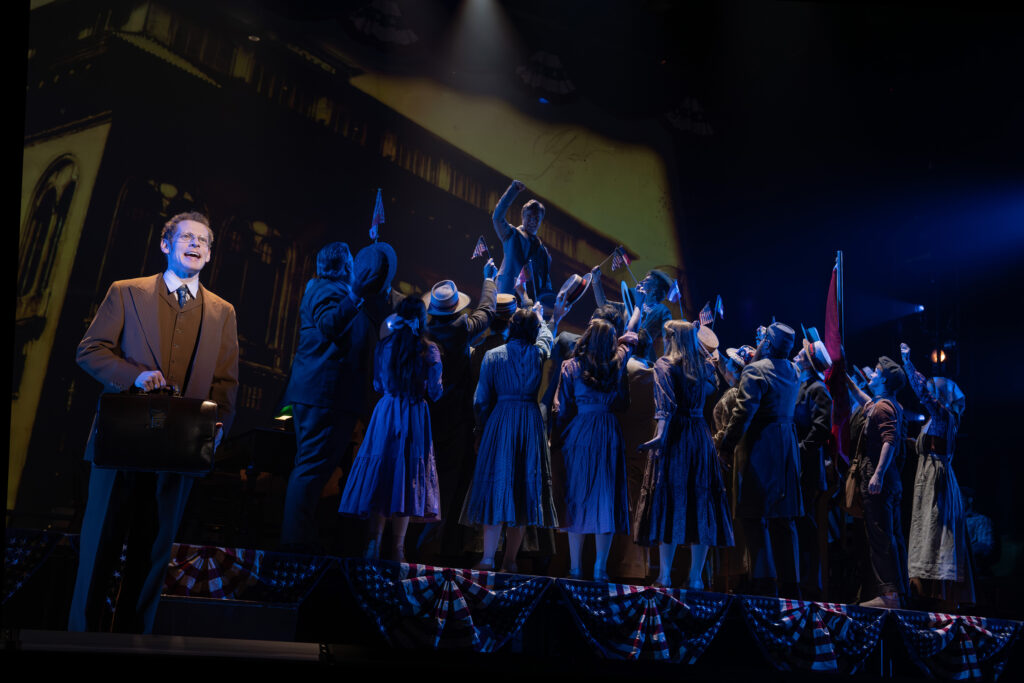
Max Chernin and the company in the National Tour of PARADE, photo by Joan Marcus.
The New York City Center production presented at the Emerson Colonial Theatre
Book by Alfred Uhry
Music and lyrics by Jason Robert Brown
Co-conceived by Harold Prince
Directed by Michael Arden
Choreography by Lauren Yalango-Grant & Christopher Cree Grant
Music direction by Charlie Alterman
U.S. Tour Website
March 11 – 23, 2025
Emerson Colonial Theatre
106 Boylston Street
Boston, MA 02116
2 hours and 30 minutes, including one intermission
Review by Kitty Drexel
BOSTON — Uhry and Brown’s Parade is at the Emerson Colonial Theatre through March 23. This heartbreaking musical about Christian nationalist antisemitism and its consequences on decent, law-abiding folk has become a musical theatre classic for the ages. It features strong choreography by Lauren Yalango-Grant & Christopher Cree Grant, decisive music direction by Charlie Alterman, and direction by Michael Arden.
Parade is based on a true story and a court case that remains open to this day. Leo (solemn and soulful Max Chernin) and Lucille Frank (strong and confident Talia Suskauer who proves that femmes are the backbone of America) are a newlywed couple struggling to make a life in the old red hills of Georgia. When Leo, a Jewish-American factory manager from New York, is falsely accused and convicted of the murder of a 13-year-old factory employee in 1913 Atlanta, it propels the couple into an unimaginable test of faith, humanity, justice, and devotion. Parade is a musical about racism, the corruption of the legal system in the name of white supremacy, the resiliency of the human spirit, and romantic love.
Please note: This production incorporates the 2007 revisions introduced by Rob Ashford for the Donmar Warehouse in London. Ashford’s production welcomed restructuring and rewriting distinctly different from the original production co-conceived by Harold Prince. Frankly, this production is kinder to Leo and Lucille Frank, recognizes the violent oppression of its “freed” Black characters, and no longer forces post-trial conjecture onto the audience.
The musical opens on a confederate soldier (Trevor James singing like an angel) saying goodbye to his pretty newlywed wife before going to fight in the Civil War in “The Old Red Hills of Home.” He sings to her about fighting to make the South “free.” Lest we forget, the South was fighting for the freedom to own Black slaves. White Southerners were otherwise factually free; their soldiers fought to own Black people. They were so sore about it, they lynched a respectable Jewish man in 1913. Jim Crow, voter suppression, the prison pipeline, and white, christian nationalism – it’s all because the South can’t get over losing the Civil War to the North.
Despite its dark subject matter, Parade is a beautifully staged, choreographed, sung, and designed production. The choreography for ensemble numbers like “The Dream of Atlanta” and “Hammer of Justice” are equally as detailed and layered as solo numbers like “Come Up to My Office (Chernin, and the Factory Girls)” and “Feel the Rain Fall (Ramone Nelson wailing the Blues with the male ensemble).” Great care is shown via the cast’s crisp vocals and absorbing acting. It’s easy to see why this production was a hit on Broadway.

Talia Suskauer and Max Chernin in the National Tour of PARADE, photo by Joan Marcus.
The scenic design by Dane Laffrey is versatile; its dressing reflects locations and time periods to keep the audience tuned into the production. It consists of a raised platform on which many of the musical’s events occur and stage-level seating. The platform becomes a trolley, a prison cell, a dance floor, and even a Memorial Day knoll for a picnic. When they are on stage, the actors sit at the stage-level and play a jury, Atlanta crowds, and patiently watch as the action unfolds on the platform.
Sven Ortel’s projection design in collaboration with Heather Gilbert’s seamless lighting design does the heavy dramaturgical work of informing the audience of the whos wheres and whys of Parade. Ortel projects onto an upstage screen historical images of Atlanta and the actual photographs of persons involved with Leo Frank’s 1915 trial. Some of those photos captured the very real lynching of Mr. Leo Frank. This Southern legacy practice was only made illegal by the federal government, despite many previous attempts, in 2022 by President Joe Biden. Ortel and Gilbert are projecting American history. Don’t look away.
The Parade Broadway website has resources for those hoping to better understand why such a photo is shown and the U.S.’s history of violence against minorities. A list of organizations, books, and cultural resources is HERE. A discussion guide by the Anti-Defamation League is HERE.
Moving on to a happier topic: Shout out to cast members Olivia Goosman (when not playing Mary Phagan, she attends BoCo) and Caroline Fairweather (a Western, MA local). Congrats on the beautiful singing and living the dream!
Congratulations to the local orchestra members: Desiree Glazier-Nazro, Jodi Hagen, Tudor Dornescu, Chris Nunn, Hyun-Ji Kwon, Julianne Russell, and Henry Roseman! Your work with the traveling orchestra helmed by Charlie Altman lifts the cast to great heights.
Bravo to swing Benjamin Magnuson for using his playbill bio to advocate for prison reform and https://innocenceproject.org/, which works to free the innocent, prevent wrongful convictions, and create fair, compassionate, and equitable systems of justice for everyone. This is what using your platform for change looks like. Thank you for your service.
